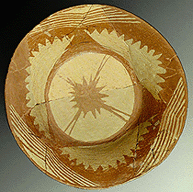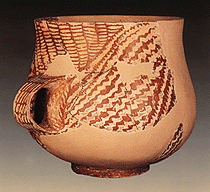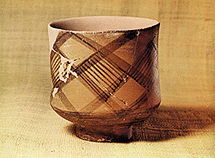 
The Middle Neolithic Period, also known as Sesklo culture, was characterized by an exceptional variety in painted decoration, while at the same time the production of good quality monochrome (brown, red and gray-black) vases, which were simple, burnished but also incised continued. In many cases an incised design was combined with a painted decoration on the same vase. During this period local pottery variations, were manifest both in the shapes and the decoration of the vases. Globular pithoid vases with a cylindrical or funnel-shaped neck, basins with flat bases, semiglobular skyphoi with or without a leg, bowls, jugs and cups with an S-profile and band handles were the most common shapes of vases in all the regions of Greece. |


In Thessaly three styles of painted ware (Sesklo É, ÉÉ and ÉÉÉ), distinct from other styles in Greece, were manufactured throughout the Middle Neolithic. In the Sesklo I style, dark red coloured stepped or checkboard motifs were painted, but also zigzag lines on a whitish slip (thin clay paint), with which the surface of the dry, but still unfired vase, was coated. This ware, more widely disseminated in Thessaly, reminiscent of patterns known from the art of weaving, is encountered in figurines and house models of the Middle Neolithic and is known by the term solid style. Sesklo ÉÉ style is characterized by the flame pattern and is ususally encountered in open bowls with flat bases. Lastly, in the Sesklo ÉÉÉ style the linear style is dominant with parallel and zigzag lines or painted stacked chevrons, contrary to the Sesklo É and ÉÉ styles, with white on the red slip of the vase or directly on its burnished surface. A variation to the painted decoration is the so-called scraped ware, encountered in Thessaly and central Greece, also known as Chaironeia style. In this case the whitish surface of the vase is covered completely with a red colour, from which parallel bands are then scraped off. At the end of the Middle Neolithic grey pottery appeared (proto-grey), characterizing the early phases of the Late Neolithic É. |

In southern Greece, and especially the Peloponnese, a new, unusual pottery ware predominated, the so-called Urfirnis. Vases of this style were wholly or partly covered with a special paint, which after firing turned reddish brown to black and acquired a distinctive lustre. With this paint, linear-geometrical drawings were painted on the surface of vases (Urfirnis painted). A variation to Urfirnis painted vases was the black painted ware on the reddish surface of a vase, located in Phocis and Boeotia. |

In the pottery of western Macedonia a red painted decoration on a whitish background was dominant, as well as a combination of painted and incised cardium ware. Painted decoration of red on white has also been encountered on the islands of the eastern Aegean (Ayio Galas-Chios), and is similar to the pottery of Hacilar in Asia Minor. The so-called Paradimi group, that prevailed in eastern Macedonia and Thrace as well as southeastern Bulgaria (Karanovo III-Veselinovo), consisted of bowls with four legs, miniature three-legged tables with incised decoration, matt-painted pottery with a burnished surface and graphite-painted decoration (ribs, grooves). |